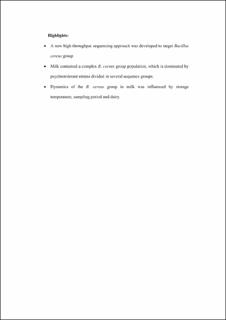| dc.contributor.author | Porcellato, Davide | |
| dc.contributor.author | Aspholm, Marina | |
| dc.contributor.author | Skeie, Siv Borghild | |
| dc.contributor.author | Mellegård, Hilde | |
| dc.date.accessioned | 2020-06-22T15:01:51Z | |
| dc.date.available | 2020-06-22T15:01:51Z | |
| dc.date.created | 2018-06-06T08:33:18Z | |
| dc.date.issued | 2018 | |
| dc.identifier.issn | 0740-0020 | |
| dc.identifier.uri | https://hdl.handle.net/11250/2659061 | |
| dc.description.abstract | Members of the Bacillus cereus sensu lato (B. cereus group) are spore-forming
organisms commonly associated with spoilage of milk and dairy products. Previous
studies have shown, by using 16S marker gene sequencing, that the genus Bacillus is
part of the core microbiota of raw bovine milk and that some members of this genus is
able to grow during sub-optimal storage (8 °C) of pasteurized consumption milk.
Here, the composition of this genus in pasteurized consumption milk samples,
collected from two dairies, over a one-year period and stored at 4 or 8 °C up to the
end of shelf life is uncovered. Our results show that the B. cereus group is the
dominant Bacillus group in stored consumption milk. By applying a new marker gene
sequencing approach, several dominating phylogenetic clusters were identified within
the B. cereus group populations from the milk samples. There was a higher
phylogenetic diversity among bacteria from milk stored at 8 °C compared to milk
stored at 4 °C. Sampling period and the dairy the samples were collected from, also
significantly influenced the diversity, which shows that the B. cereus group
population in consumption milk is heterogeneous and subjected to temporal and
spatial changes. The new approach applied in this study will facilitate the
identification of isolates within the B. cereus group, of which some are potential
spoilage bacteria and pathogenic contaminants of milk and dairy products. | en_US |
| dc.language.iso | eng | en_US |
| dc.rights | Attribution-NonCommercial-NoDerivatives 4.0 Internasjonal | * |
| dc.rights.uri | http://creativecommons.org/licenses/by-nc-nd/4.0/deed.no | * |
| dc.title | Application of a novel amplicon-based sequencing approach reveals the diversity of the Bacillus cereus group in stored raw and pasteurized milk | en_US |
| dc.type | Peer reviewed | en_US |
| dc.type | Journal article | en_US |
| dc.description.version | acceptedVersion | en_US |
| dc.source.journal | Food microbiology | en_US |
| dc.identifier.doi | 10.1016/j.fm.2018.01.014 | |
| dc.identifier.cristin | 1589296 | |
| dc.relation.project | Norges forskningsråd: 244149 | en_US |
| cristin.unitcode | 192,12,0,0 | |
| cristin.unitcode | 192,16,2,0 | |
| cristin.unitname | Kjemi, bioteknologi og matvitenskap | |
| cristin.unitname | Institutt for mattrygghet og infeksjonsbiologi | |
| cristin.ispublished | true | |
| cristin.fulltext | postprint | |
| cristin.qualitycode | 1 | |

